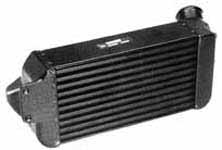
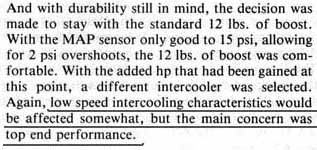
Gary's
information page on intercooling
What exactly does intercooling do? Mostly, just what the name implies.
Adding an intercooler will greatly reduce the intake temperature, a 70-200°F drop in air temperature (dependent upon application) results in a more dense, powerful fuel/air charge, greatly reduces exposure to detonation, and virtually eliminates the power fade felt in back-to-back runs and extended pulls without intercooling. This reduction in temperature will allow higher boost levels to be run safely without fear of knock.
Garry W.
McKissick,
Jr.
Basically what Garry is trying to say is if you want to make "THE BIG POWER" your going to need an intercooler. Without an intercooler you are more prone to detonation & piston damage, limited on how much boost you can safely run on pump gas (about 15 psi vs 25 on the same gas) and how much power you can generate.
Below
are links to sites with tips about intercooling, some specs, and some cars
that have been intercooled in unique ways...
Before we scroll down to the links, I have a word of advice. Mopar Performance sells an intercooler (PN: P5249331) as part of their "Super 60" package, as a rule of thumb I do not recommend purchasing it for any reason, here is why...
It has 15 fins per inch vs 22 for the stocker, basically this means that the stock intercooler has more radiating surface then the S60 intercooler does. The S60 intercooler will flow more air! I don't dispute that. The trade off is it won't cool it as well. The reason why this intercooler exists is threefold..


1) In 1987 Mopar paced the Indy 500 with a Turbo Lebaron, as you can see in the above clip from Mopar Performance's own 2.2 book (Pn: P4452792, page 343) Engineers were more concerned with turbo compressor backpressure and high speed performance then low speed cooling efficiency.
2) I hear this one through the grapevine from a reliable source. Shelby had some Turbo CSX's entered in some racing classes. From what I'm told some of the racers were slipped "stock looking" intercoolers for more horsepower. I assume these guys were running race gas so the chances of detonation were pretty slim. This would not be the first time I have heard of Shelby pulling something tricky like this!
3) The Super 60 package itself is an "off road only" racing package. Most race cars use race gas! I asked a Chrysler engineer at a SDAC-5 seminar "when did this intercooler start working better than the stock one" and was told "at speeds over 60mph" to which I replied "but the race is just about over by then." The fellow was VERY concerned about compressor backpressure.
To be fair the stock intercooler does start do have a fair amount of pressure
differential between the inlet and outlet once the boost starts going up.
I'm told less then a pound or two is ideal and at 15 psi the stock one
is about 2 psi, however... I have been running very high boost with stock
intercoolers for a number of years with no ill effects to the turbo noted.
My Daytona currently has 136,000 miles on its turbo at the time I'm writing
this and when I'm racing the car it sees an indicated 30 psi of boost in
third and forth gear!! (car has run a best of 12.6 with a stock intercooler
to date) I'm sure the backpressure is mighty high, as a matter of fact
I know it is!
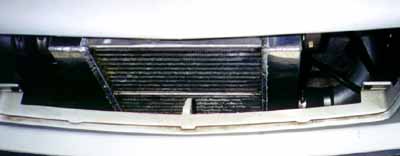
In the K-car I removed the stock intercooler and replaced it with TWO stock intercooler cores that had been welded together. Boost went from 25 psi to 30 psi with no other changes! The K-car HAS run ELEVEN'S on a stock intercooler though!
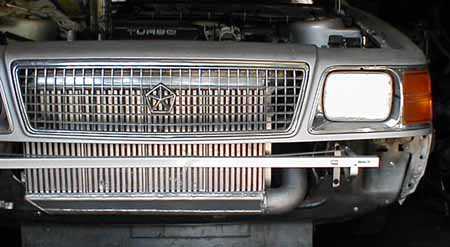
Relentless sports FOUR stock cores welded together now!
My recommendation
is to use a stock intercooler up to about 20-21 psi, after that you will
see an advantage moving on to a larger, higher flowing unit.
Some Intercooling links from around the World Wide Web
Chad Kilback's Daytona which has not one, but TWO intercoolers!
Joe O'Connor's 86 Turbo Z Daytona has 2 Intercoolers also! (Late model Turbo II intake)
John Rivait has a GLH Omni that's packing a Volvo intercooler...
Daniel Culkin has a Volvo intercooler as well in his 86 Turbo Z Daytona C/S (with EARLY intake manifold)
Chris Roth has a Volvo intercooler stuffed into his SVO Mustang, check out the pictures here! (great site)
(I'd like to point out at this point the Volvo intercooler is very popular due to it's large size and price- used they run about $100-$150. The core design (tube style) is not as efficient at cooling as a stock intercooler (fin on fin) but makes up for it with sheer size.
Garry McKissick has a great page on installing an Conquest intercooler in a CSX-T Shadow AND graphs of the pressure and temperature changes.
Leon
Bellavance has a Daytona with a Cummins Diesel intercooler in it!!!
Jan
Daurio has a Cummins Diesel intercooler in his Daytona as well.
Jack
H.F Ng 1991 Shelby Daytona has been intercooled with a early factory
intercooler in a remote location.
Paul
Smith's 1989 Dodge Caravan is packing a GIANT 1999 Ford Power Stroke
Diesel pick-up intercooler.
Gus
Mahon has a large intercooler installed on his 13 second Caravan
as well as his 12 second Acclaim.
You can check out more pictures of the K-car's intercooler here as well as pictures of my Daytona's prototype air-to-water intercooler here.
Mike Marra was nice enough to submit an article on chemical intercooling with water/alcohol...
And while
your at it, have a gander at my intercooler
spotting guide...
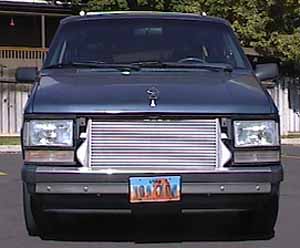
Dempsey Bowling joins the fun with a great page on how to install a Powerstroke unit in a Caravan.